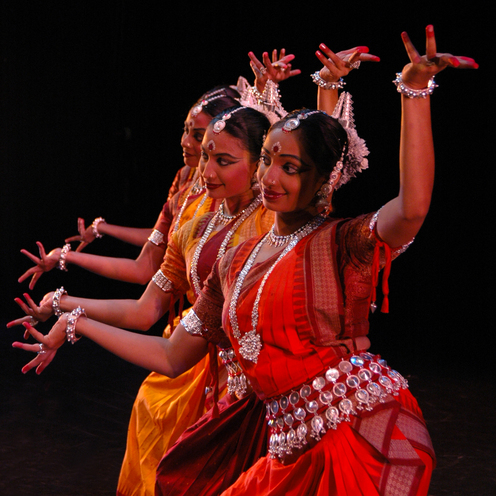…in case you have yet to catch this phenomenal odissi ensemble on their U.S. tour, their performance at the Wang Theater of the Stony Brook University campus in Long Island on Sunday is your last chance.
In a Newsday preview from this Sunday’s paper, I discuss how the all-female ensemble has “extended an ancient tradition without stretching it thin.” No mean feat. Here’s the story:
BY APOLLINAIRE SCHERR
Special to Newsday
“Odissi is based on the s curve – the infinity curve,” says artistic director Surupa Sen about the Indian classical dance form that Nrityagram Dance Ensemble brings to Stony Brook University next Sunday. “We never really finish a circle and we never make a straight line. Even our eyes won’t look directly. There’s always a little bit of an arc, which gives the movement a sensuality and a sculpturalness.”
As it should. Hundreds of years old, Odissi grew out of the voluptuous poses of temple sculptures in northeastern India. “Odissi carries images of another lifetime,” Sen says. “In a sense, our dance belongs to another world.”
In another sense, though, it belongs very much to this one. In the past decade, the company of five women from a dance commune outside Bangalore has achieved renown across India, in Europe and the United States because it has succeeded where many contemporary groups have fallen flat. It has extended an ancient tradition without stretching it thin.
The contours of a Nrityagram show are conventional enough, beginning with an invocation to a Hindu deity and ending with a prayer. And the stories the dancers tell derive from ancient texts, as do the myriad evocative gestures with which they tell them. But Sen, the troupe’s choreographer, also takes selective advantage of the Western dance arsenal: the jump and reach, and the poetic possibility of group set against solo.
It’s common in Odissi to turn–with the upper body moving in mesmerizing figure eights a beat behind the hips–and to gallop. But because Odissi dancers often continue past middle age, the turns tend to be demure and the jumps low to the ground. Not here. Thanks to the latest body-conditioning techniques, Nrityagram dancers bound into the air with ferocious spirit and their chain of turns conjures a storm. When the steps grow calm again– the body settling into that suggestive s — the contrast is palpable.
Odissi is traditionally a solo form, with one person playing all the characters and traveling back and forth in time. Sen, however, has two dancers trading off in the roles, to profound effect. Take, for example, a dance in which a young woman catches sight of Krishna pining away for the goddess Radha and runs to tell Radha. “Our religion has always been celebration–mostly of love,” Sen explains. But the additional dancer makes the relationship between the lovers no more important than that between the two women or between the storyteller and the listener, including us. Sen sweeps us in especially close.
Sen’s innovations have caused some traditionalists to accuse her of transgressing classical dance’s frame. “But I don’t know what they mean,” she says. She likens Indian classical dance to Sanskrit, which “is already like poetry, because it contains the roots of so many other languages.” The root language that India’s 2,000-year-old dance-theater bible, the Natya Shastra, lays out is meant to blossom into new images, she argues.
Life at Nrityagram — the rural dance village established 18 years ago by ensemble founder Protima Gauri, who died in 1998 — lends itself to this methodical approach. Brilliant senior dancer Bijayini Satpathy has “just discovered Google,” she exclaims, for searching out Sanskrit stories for the dances, but otherwise the dancers’ routine is decidedly low-tech.
Dance class, rehearsal, household chores, yoga and tending their individual garden plots: the workday starts at 5:30 a.m. and ends at 10 p.m. On weekends, the dancers sleep in, wash piles of sweaty practice clothes and teach the local children. Once upon a time, soloist Pavithra Reddy rode her bike to Nrityagram from the family farm nearby for these free classes.
There is little to keep them from their devotion — no male dancers, for example, “carrying lots of chips on their shoulders because they don’t want to be bossed around by a woman,” says Sen.
Still, a person has to learn to make this humble lifestyle work for her. It took Sen years. “I’ve grown up mostly in cities,” she says. “I didn’t know one leaf from another when I first came to Nrityagram. This relationship that Protima wanted us to have with the land, I understood only after she died. It’s the development of something from the seed.”
WHEN&WHERE Nrityagram Dance Ensemble performs “Pratima: Reflection” Sunday April 13 at 6 p.m. at the Wang Theater at Stony Brook University. Tickets $10-$15; $25 for first three rows. Call 631-632-4400 or e-mail wangcenter@stonybrook.edu. (A workshop will be held Monday 1:30-3:30 p.m., free for ticket holders; $10 others.)
Copyright © 2008, Newsday Inc.
Photo by Stephanie Motta. Pictured first and second in this curvaceous line up are soloists Pavithra Reddy and Bijayini Satpathy.


please let me know when can common people come and enjoy the talents in nrithyagrama.
Hello, Asha, I I know they teach free “village outreach” classes every Sunday. Here is more contact information at their website: http://www.nrityagram.org/contact/contact.htm
Good luck: they are very skilled, very good people. I’m sure it would be a treat to learn from them. Best, Apollinaire